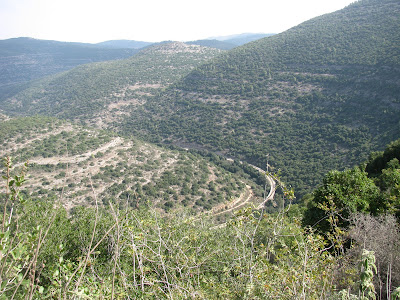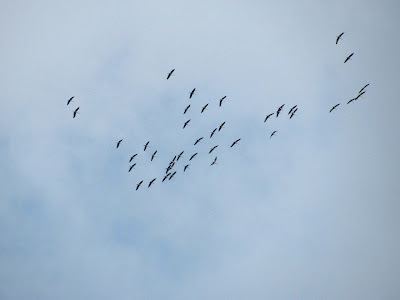Our hike above Nahal Sorek, one of the largest and most important drainage basins in the
Judean Hills, was one of the hardest hikes Mister Handmade in Israel and I have done in the last few months, though it was also an extremely beautiful one. The circular hike overlooks the Sorek Stream and passes by the ruins of Tur Shimon, a Hasmonean fortress, above. Throughout the hike the views of the Sorek Valley and the surrounding hills were spectacular and, though we were tired by the end of it, I was so glad we did it.





Nahal Sorek is a deep valley that begins close to
Ramalla and winds its way through the Judean Hills and the
Shfela (lowlands) to the
coastal plain. In ancient times it was a thoroughfare to Jerusalem and there were agricultural settlements along its path. The name
sorek comes from the root שרק, "red grapes" and refers to the vines that grew along the valley. Over the years this area was known for its grapes and today there are a number of fine boutique wineries in the district.
Nahal Sorek was the place where
Delilah lived, and
Samson came to meet her for the first time. It was also the place she enticed him to tell her the secret of his strength, and where he was eventually captured by the Philistines:
And Samson went to Gaza… And it came to pass afterward, that he loved a woman in the brook/valley of Sorek, whose name was Delilah. And the lords of the Philistines came up to her, and said to her: "Entice him, and see wherein his great strength lies, and by what means we may prevail against him, that we may bind him to afflict him…"
-
Judges Chapter 16:4
Nahal Sorek is known in Arabic as Wadi es-Sarār.







We started our hike on a blue-marked jeep trail from which there were amazing views of the Sorek Valley, soon turning onto a black-marked footpath which runs alongside the valley. Climbing ever downwards the landscape around us began to change. From a rocky footpath and gorgeous views of the valley, we entered a wooded area with many
Katlav trees.
Katlav is the Hebrew name of a striking, red-barked evergreen tree native to the Mediterranean region, also known as the Greek Strawberry tree or
Arbutus Andrachne. The bark is smooth and sheds during the summer, leaving a pistachio green colour, which changes gradually to a beautiful orange brown. The small red berries of the Katlav tree apparently taste like tart strawberries and ripen in November, though I was too scared to try them.

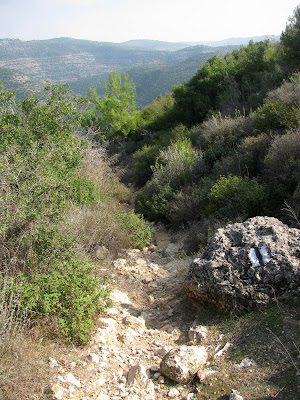
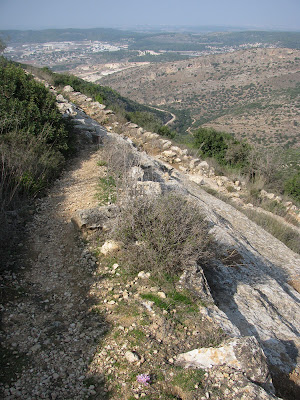



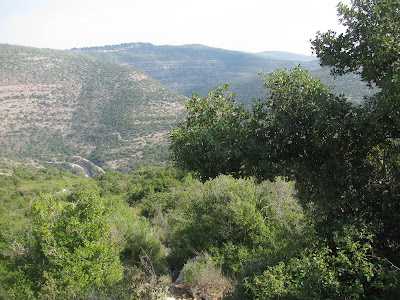

Walking along the black-marked footpath we had a continuous view of the old Tel Aviv-Jerusalem railway which runs through this valley, above. In the 19th century, Nahal Sorek served as an important connection between the two major cities in the area, Jaffa and Jerusalem. Because railways at the time were reliant on water sources, several surveyors who planned the first railway in the Middle East, the
Jaffa–Jerusalem line, decided to use Nahal Sorek as the main route for the line. It was inaugurated under
Ottoman rule in 1892 and connects Tel Aviv with the Jerusalem Malha station via Beit Shemesh. The scenic winding ride takes 1 hour 40 minutes.
A new high-speed railway line connecting Tel Aviv and Jerusalem avoids Nahal Sorek and its curves, instead using bridges and tunnels to bypass the hills and valleys, but the older railway along Nahal Sorek has been refurbished and remains in use. There used to be an ancient road here, but it was dug up when the railway was established.
We finally spotted Tur Shimon or Horvat Tura, in the distance, below. These are the ruins of a royal fortress from the
Hasmonean period. The Arabic names of the site -
Khirbet Sammunieh and
Khirbet Tantura - preserve the ancient name of the fortress "Tur Shimon", or the Mountain of Shimon. The fortress may have been built by
Shimon, the son of the Hasmonean ruler
Matityahu, or by Shimon's son, in memory of his father. Naming fortresses after other rulers, family or friends was common in the Hellenistic and Roman world. In maps of the
British Mandate period the ruin is also named
Khirbet et-Tantura ("Ruin of the Point"), so-called after the shape of the hill.
Tur Shimon overlooks the Sorek Valley and had strategic significance in protecting the approach to Jerusalem. Six large underground cisterns provided water. It continued to be inhabited until the
Bar Kokhba revolt, when it was destroyed. During the Crusader period, a fortress or fortified farmhouse was built on the ruins of the Hasmonean fortress.
A trough beneath Tur Shimon
Tur Shimon, which rises 595 metres (1,952 ft) above sea level, has not been excavated. Mister Handmade in Israel and I got halfway up but struggled without a pathway. The hill is covered with brushwood and wild growth, ashlars and partially standing walls of stones. The grounds are apparently strewn with fragments of ancient pottery from the
Hellenistic period, the early
Roman period, the
Iron Age and from the
Byzantine era. I'll try again another time!
Returning to the blue trail, it was a steep climb up the side of the valley and there was some rock climbing required. After about 45 minutes we reached the top where a jeep trail on the top of the ridge returned us to our starting point. We had enjoyed wonderful views of the surrounding hills, including a glimpse of Jerusalem and of the
zawiya (an Islamic religious school or monastery) at Dayr al-Shaykh, above, a Palestinian Arab village which was deserted during the 1948
War of Independence. It had been an exhausting but wonderful hike!




























































